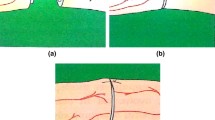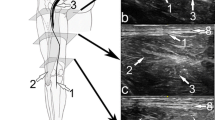Abstract
Background
The use of free vascularized nerve grafts requires an intimate and accurate knowledge of the blood supply of peripheral nerve. This study was designed to compare the advantages and disadvantages of three methods employed to reveal the blood supply of the peripheral nerve, and to provide morphological basis for vascularized nerve grafts.
Methods
The blood supply of brachial plexus and its main branches (ulnar, median, radial, musculocutaneous and axillary nerve) were observed using three vascular injection techniques: three specimens were injected with red latex through the thoracic aorta; two side specimens were injected with a Chinese ink solution, through the subclavian artery, for diaphanization and histology; one fresh cadaver was injected with the gelatin–lead oxide mixture through the femoral artery for radiography.
Results
The blood supply of the brachial plexus and its main branches was well examined using the three different vascular injection techniques. Perfusion with red latex exposed the extrinsic blood supply. Diaphanization and histology showed the intrinsic blood supply, while gelatin–lead oxide injection technique interactively displayed both the intrinsic and extrinsic blood supply to the peripheral nerve.
Conclusion
The standard method for the study of the extrinsic blood supply to the peripheral nerve is the red latex perfusion; diaphanization and histology are very suitable to study the intrinsic blood supply of the peripheral nerve; while gelatin–lead oxide technique is the standard for visualization of the integral topography of the blood supply of the peripheral nerve.




Similar content being viewed by others
References
Bergeron L, Tang ML, Morris SF (2006) A review of vascular injection techniques for the study of perforator flaps. Plast Reconstr Surg 117:2050–2057
Bertelli J, Khoury Z (1991) Vasculariarization of the lateral and medial cutaneous nerves of the forearm: anatomic basis of neuro-cutaneous island flaps on the elbow. Surg Radiol Anat 13(4):345–346
Blunt MG, Stratton K (1956) The immediate effects of ligature of vasa nerverum. J Anat Lond 90(2):204–216
el-Barrany WG, Marei AG, Vallee B (1999) Anatomic basis of vascularised nerve grafts: the blood supply of peripheral nerves. Surg Radiol Anat 21(2):95–102
Hattori Y, Doi K, Ikeda K et al (2005) Vascularized ulnar nerve graft for reconstruction of a large defect of the median or radial nerves after severe trauma of the upper extremity. J Hand Surg [Am] 30(5):986–989
Hong MK-H, Hong MK-Y, Taylor GI (2006) Angiosome territories of the nerves of the upper limbs. Plast Reconstr Surg 118(1):148–160
Isenflamm JF, Doerffler JF (1768) De Vasis Nervorum. Erlanggen
Li J, Jiang BG, Wang W et al (1995) The advancement and clinical application of the blood supply of the peripheral nerve. Prog Anat Sci 1(2):118–122
Lundborg G (1979) The intrinsic vascularization of human peripheral nerve: structural and functional aspects. J Hand Surg 4(1):34–41
Ramage D (1927) The blood supply to the peripheral nerves of the superior extremity. J Anat 61:198
Spalteholz W, Hirsch C (1907) Coronararterien und Herzmuskel: Anatomische und experimentelle Untersuchungen. Dtsch Med Wochenschr 1:790 (in German)
Steinke H, Wolff W (2001) A modified Spalteholz technique with preservation of the histology. Ann Anat 183:91–95
Suami H, Taylor GI, Pan WR (2003) Angiosome territories of the nerves of the lower limbs. Plast Reconstr Surg 112(7):1790–1798
Sunderland S (1945) Blood supply of the nerve of the upper limb in men. Arch Neurol Psychiat Chicage 53(2):91–115
Tang ML, Geddes CR, Yang DP et al (2002) Modified lead oxide–gelatin injection technique for vascular studies. Clin Anat 1(1):73–78
Taylor GI (1999) Free vascularized nerve transfer in the upper extremity. Hand Clin 15(4):673–695
Taylor GI, Ham FJ (1976) The free vascularized nerve graft: a further experimental and clinic application of microvascular techniques. Plast Reconstr Surg 57(4):413–426
Xu J, Gu YD, Cheng XM et al (2001) The anatomical study of vascularized ulnar nerve graft pedicled with the superior collateral ulnar artery. Chin J Clin Anat 19(2):108–110 (in Chinese)
Author information
Authors and Affiliations
Corresponding author
Rights and permissions
About this article
Cite this article
Peng, TH., Ding, HM., Chen, SH. et al. Demonstration of three injection methods for the analysis of extrinsic and intrinsic blood supply of the peripheral nerve. Surg Radiol Anat 31, 567–571 (2009). https://doi.org/10.1007/s00276-009-0480-4
Received:
Accepted:
Published:
Issue Date:
DOI: https://doi.org/10.1007/s00276-009-0480-4




